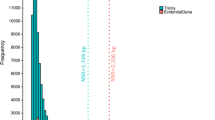Abstract
The top-mouth culter Erythroculter ilishaeformis is a kind of carnivorous fish that is currently a widely distributed fish in China, which is a commercially important freshwater fish in China. However, only few effective molecular markers on E. ilishaeformis are available. In this study, nine muscles and liver tissues of cDNA libraries of E. ilishaeformis were sequenced using Illumina HiSeq4000 paired-end sequencing technology. 86,574 sequences from 80,945,107 paired-end reads were generated. 55 novel simple sequence repeat (SSR) markers were developed based on high-throughput sequencing. After genetic diversity analysis, observed heterozygosity (Ho) was from 0.1613 to 0.4839. Expected heterozygosity (He) was from 0.1507 to 0.3728. Minor allele frequencies (MAFs) were from 0.3333 to 0.5000, and Hardy-Weinberg values were relatively balanced. These SSR markers developed from transcriptome sequencing will be as a useful tool to exploit populations genetic of E. ilishaeformis.
Similar content being viewed by others
References
Chistiakov DA, Tsigenopoulos CS, Lagnel J (2008) A combined AFLP and microsatellite linkage map and pilot comparative genomic analysis of European Sea bass Dicentrarchus labrax L. Anim Genet 39:623–634
Clarke KR, Gorley RN (2001) PRIMER v5: user manual/ tutorial. PRIMER-E, Plymouth
Divu D, Khushiramani R, Malathi S (2008) Isolation, characterization and evaluation of microsatellite DNA markers in giant freshwater prawn Macrobrachium rosenbergii, from South India. Aquaculture 284:281–284
Guo S, Zheng Y, Joung JG (2010) Transcriptome sequencing and comparative analysis of cucumber flowers with different sex types. BMC Genomics 11:1–13
Huang AH, Zhang DZ (2010) Diagnosis and control of common diseases of Erythroculter ilishaeformis. Wealthy Fish Guide 45:47
Huang W, Zhu ZY, Yu N, Mei XJ (2015) Overview of research progress and breeding patterns of the nutritional requirements of Erythroculter Ilishaeformis. China Veterinary Animal Husbandry Diges 31:105–106
Huang YF, Duan GQ, Peng LP (2019) Reviews on the resource status and biological characteristics of cluter alburnus. J Anhui Agricult Sci 47:10–13
Huang CW, Chu PY, Wu YF (2020) Identification of functional SSR markers in freshwater ornamental shrimps Neocaridina denticulata using transcriptome sequencing. Mar Biotechnol 22:772–785
Karaket T, Poompuang S, Na-Nakorn U (2011) DNA microsatellite-based evaluation of early growth performance among strains of freshwater prawn Macrobrachium rosenbergii De Man. Aquaculture 311:115–122
Li H, Fan LQ (2021) Erythroculter ilishaeformis breeding technology. Wealthy Fish Guide 5:54–59
Li DS, Ming DL (1991) The nutritional value of Parabramis pekinensis and Culter fish. J Amino Acids 5:36–38
Ruan H, Xu SN, Li M (2020) Selection of bay fish microsatellite loci and the genetic diversity analysis of five geographic populations in the Pearl River Basin. J Hydrobiol 44:501–508
Sha Z, Sha Y (2022) Efficient pond mixing technology for Erythroculter Ilishaeformis. Sci Fish Farming 5:39–40
Thiel T, Michalek W, Varshney RK, Graner AA (2003) Exploiting EST databases for the development and characterization of genederived SSR-markers in barley (Hordeum vulgare L). Theor Appl Genet 10:411–422
Tian J, Peng D, Wen H, Wang GY, Li P, Chen J, Sun YH, Lu X, Wu F, Li Q (2020) A comparative study on protein-sparing effects among juvenile Erythroculter ilishaeformis line, Ancherythroculter Nigrocaudaline and their hybrid F1 fed diets with different protein to carbohydrate ratios. Aquacult Nutr 26:993–1006
Yang L (2015) Nutrient composition analysis of wild and farmed red Erythroculter ilishaeformis muscle from Chaohu Lake. Meat Ind 5:18–22
Yeh FC, Yang R, Boyle T, Ye Z, Xiyan J (2000) Popgene 1.32: Microsoft Windows-based freeware for population genetic analysis. Mol Biol Biotechnology Cent. University of Alberta, Edmonton, Alberta, Canada
Yin HB, Yin JS, Xu W (2003) Analysis of the nutrient composition of the muscles of Erythroculter Ilishaeformis in Xingkai Lake. China Fisheries Sci 10:82–84
Acknowledgements
The authors would like to express their contribution to the contribution made by Shanghai Meiji Biological Co.
Funding
This work was supported by University Natural Science Research Project of Anhui Province, China (KJ2019ZD59); the Key Research and Development Plan Project of Anhui Province, China (1804a07020119); the Special Fund for Anhui Agriculture Research System, China.
Author information
Authors and Affiliations
Contributions
HX: Investigation, Data curation, Methodology, Formal analysis and Writing—original draft. DJ and BG: Investigation, Methodology, Formal analysis. MX: Data curation, Formal analysis, Methodology, Software, Writing—original draft, Writing review & editing. All authors reviewed the manuscript. All authors read and approved the final manuscript for submission.
Corresponding author
Ethics declarations
Conflict of interest
We declare that we have no financial and personal relationships with other people or organizations that can inappropriately influence our work, there is no professional or other personal interest of any nature or kind in any product, service and/or company that could be construed as influencing the content of this paper.
Ethical approval
Investigations and protocols were conducted according to the guiding principles for the use and care of laboratory animals and in compliance with Huainan Normal University Institute of Animal Care and Use Committee. The institutional review board approved this procedure. Our study had been submitted to and approved by the Academic Ethics Committee of Huainan Normal University. All sample collection was undertaken in accordance with relevant Academic Ethics Committee of Huainan Normal University guidelines and regulations.
Additional information
Publisher’s Note
Springer Nature remains neutral with regard to jurisdictional claims in published maps and institutional affiliations.
Rights and permissions
Springer Nature or its licensor (e.g. a society or other partner) holds exclusive rights to this article under a publishing agreement with the author(s) or other rightsholder(s); author self-archiving of the accepted manuscript version of this article is solely governed by the terms of such publishing agreement and applicable law.
About this article
Cite this article
Xu, H., Gong, B., Ju, D. et al. Development of SSR markers in top-mouth culter (Erythroculter ilishaeformis) based on high-throughput sequencing. Conservation Genet Resour 16, 17–22 (2024). https://doi.org/10.1007/s12686-023-01336-0
Received:
Accepted:
Published:
Issue Date:
DOI: https://doi.org/10.1007/s12686-023-01336-0



